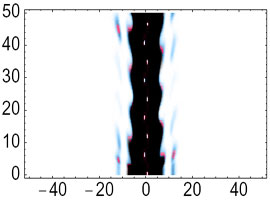| |
 Optical solitons are used to code bit signals in data streams transmitted through a multi-channel telecommunication
networks. Multiple factors, such as polarization mode dispersion, temporal instabilities, Gordon-Haus time jitting
effects, four-wave mixing and others, lead to degradation of the bit-noise ratio between optical signals and accumulative
disturbances in the network. These factors become dominant obstacles for the use of optical solitons in transoceanic
telecommunication lines that extend over thousand miles. New revolutionary upgrading technologies, dispersion and
nonlinearity management, are designed to reduce the degradation factors.
Optical solitons are used to code bit signals in data streams transmitted through a multi-channel telecommunication
networks. Multiple factors, such as polarization mode dispersion, temporal instabilities, Gordon-Haus time jitting
effects, four-wave mixing and others, lead to degradation of the bit-noise ratio between optical signals and accumulative
disturbances in the network. These factors become dominant obstacles for the use of optical solitons in transoceanic
telecommunication lines that extend over thousand miles. New revolutionary upgrading technologies, dispersion and
nonlinearity management, are designed to reduce the degradation factors.
Propagation of optical solitons is modeled numerically by scalar, vector, and periodic nonlinear Schrodinger equations.
Mathematical studies in optical solitons in nonlinear Schrodinger equations focus on solutions of three central problems:
(i) existence of stationary solutions
(ii) linear stability with respect to the time evolution
(iii) nonlinear propagation and interactions
Using asymptotic analysis and numerical modeling of differential equations,
we derive conditions for bifurcations, multiplicity, persistence, and stability of stationary optical solitons in the
nonlinear Schrodinger equations with space-periodic potentials and time-periodic dispersion and nonlinearity coefficients.
Applications include optical communications, Bose-Einstein condensates, and optical lattices.
|
|